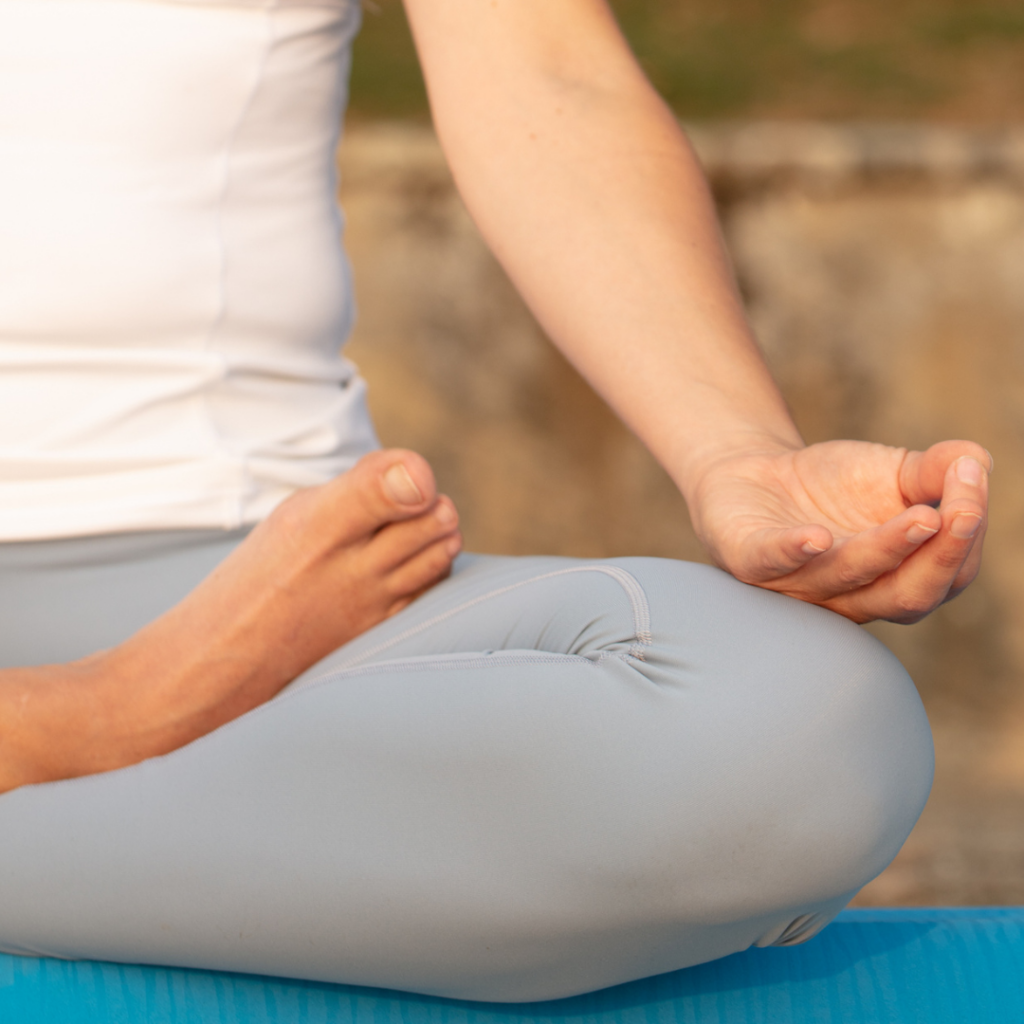In this blog post, we’ll delve into the most common myths around meditation and the truth behind them, along with some practical tips to get you started on your meditation journey.
Have you ever read about meditation and planned to start but didn’t follow through?
Meditation can seem daunting or unapproachable due to several common myths, which I’ll clear up below. Let’s get started!
Myth 1: You Need to Sit Cross-Legged on the Floor
Truth: You can meditate in any position that is comfortable for you.
The image of a serene person sitting cross-legged on the floor might be iconic, but it’s not a requirement. What’s most important is finding a position that allows you to relax without causing discomfort. You can sit in a chair, on your sofa, or even lie down if that works best for you. Personally, I meditate sitting cross-legged on my sofa, and it’s perfectly effective! The goal is to create a posture that supports a relaxed yet alert state, without straining your body.
Myth 2: You Need to Empty Your Mind
Truth: It’s impossible to completely empty your mind; meditation is about observing your thoughts without attachment.
One of the biggest misconceptions is that you need to achieve a state of complete mental blankness. This can be intimidating and unrealistic, especially for beginners. The mind naturally produces thoughts, and trying to force it into silence can lead to frustration. Meditation is more about creating a space where you can observe your thoughts without getting caught up in them. When your mind wanders, gently bring your focus back to your breath or your chosen point of concentration. The practice of noticing when your mind has wandered and bringing it back is itself a core component of meditation.
Myth 3: You’ll Have to Meditate for Hours
Truth: Even a few minutes of meditation can be beneficial.
The idea that you need to meditate for hours every day is another myth that can discourage people from starting. While long meditation sessions can be profound, the benefits of meditation can be experienced with much shorter periods. Starting with just 5 to 10 minutes a day can make a noticeable difference in your stress levels and overall well-being. As you become more comfortable with the practice, you can gradually increase the duration to 15 or 30 minutes. Remember, consistency is more important than duration.
Myth 4: You’ll See Quick Results
Truth: Meditation is a practice, and like any practice, its benefits accrue over time.
Some people expect to feel a profound sense of peace and clarity immediately after their first meditation session. While it’s possible to experience some immediate benefits, such as a sense of relaxation, the deeper benefits of meditation, such as increased mindfulness and reduced stress, typically develop over time with regular practice. Be patient with yourself and maintain a consistent practice, and you’ll begin to notice the positive effects.
Myth 5: You Need to Meditate Early in the Morning
Truth: The best time to meditate is whenever it fits into your schedule.
While meditating early in the morning has its benefits, it’s not the only time that works. The best time to meditate is the time that you can consistently set aside in your day. Whether it’s in the morning, during lunch, or before bed, choose a time that fits your lifestyle and allows you to practice regularly. This is especially important for those leading a busy life, where flexibility is key to maintaining a consistent meditation practice.
The reason I meditate first thing in the morning is simply to ensure it happens daily. Once the day starts, I never know if I’ll find time for it, and meditating in the evening is a huge struggle for me, because I tend to fall asleep.
Meditation – Practical Tips to Get Started
- Find a Comfortable Seat: Choose a comfortable spot where you can sit without distraction. It could be your sofa, a chair, or even a cushion on the floor.
- Choose a Time That Suits You: Pick a time of day that works best for your schedule. Consistency is more important than the specific time of day.
- Start with Guided Meditations: If you’re new to meditation, guided sessions can be incredibly helpful. Apps like Insight Timer and Headspace offer a wide range of guided meditations tailored to different needs and experience levels.
- Aim for 15 to 30 Minutes: While even 5 minutes can be beneficial, aiming for 15 to 30 minutes can provide a more substantial experience. Find what works best for you and your schedule.
- Be Patient with Yourself: Remember that meditation is a practice. Don’t be discouraged if you find it challenging at first. With time and regular practice, it will become easier and more rewarding.
Benefits of Meditation
Meditation offers a multitude of benefits that can enhance your overall quality of life. Here are a few:
- Reduces Stress and Overwhelm: Meditation helps to calm the mind and reduce the production of stress hormones.
- Improves Focus: Regular practice enhances concentration and mental clarity.
- Promotes Emotional Health: Meditation can lead to improved self-awareness and a more positive outlook on life.
- Enhances Sleep: Many people find that meditation improves the quality of their sleep.
- Boosts Immunity: Studies suggest that meditation can strengthen the immune system.
Meditation doesn’t have to be complicated or time-consuming. By debunking these common myths and incorporating meditation into your daily routine in a way that suits you, you can begin to experience its profound benefits. Start small, be patient with yourself, and enjoy the journey towards a calmer, more mindful life.
Remember, meditation is especially beneficial for those leading a busy life, offering a chance to pause, reflect, and find calm amidst the chaos.
If you would like to develop a regular meditation practice and enjoy all the related benefits, which will create a ripple effect in your entire life, join the Mindful Parenting Course. Learn more about it and sign up for the waitlist for the next starting date in September HERE.



